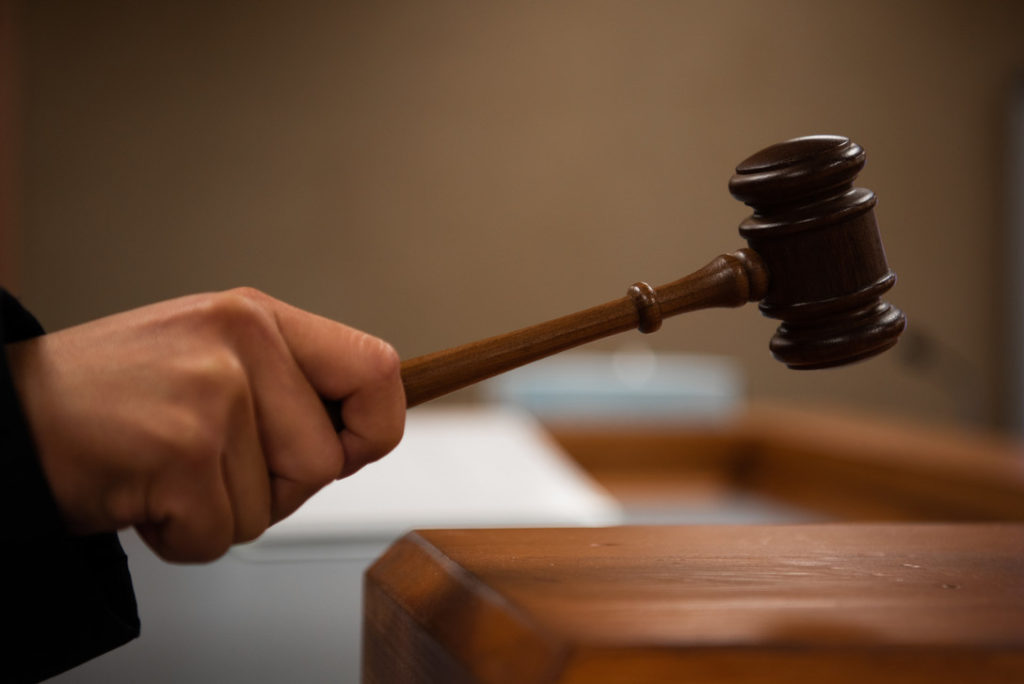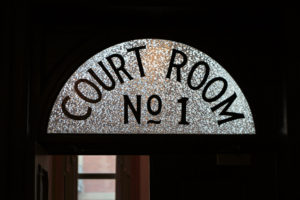12 Wake Forest L. Rev. Online 66
Craig S. Lerner[1]
Executive clemency for the dead is not unknown in American history, but it is rare. In recent years, there have been several high-profile instances, emblematic of an incipient trend that figures to grow as Americans become more conscious of, and determined to rectify, past injustices perpetrated under color of law. Posthumous pardons are inevitably celebrated for repudiating past injustices and restoring faith in the legal system.
This Article views this widely praised phenomenon with skepticism. With the goal of piercing the rhetorical fog that envelops this issue, it considers the legal merits of two recent cases: the “Martinsville Seven,” who were pardoned, and George Floyd, who was not. From these examples, the Article draws cautionary lessons on the appropriate uses of pardons to exonerate the dead. In short, the benefits are generally reaped by the politicians issuing them; the costs are borne by the living individuals whose meritorious cases for pardons were never considered. A pardon is a legal remedy designed to achieve concrete objectives, such as the liberation of a wrongly convicted, excessively punished, or genuinely repentant person. Except in extraordinary circumstances, involving the most clearly proven and outrageous injustices, when the putative beneficiary is already dead, a pardon is an ill-chosen vehicle for the delivery of nebulous symbolic benefits.
Introduction
On August 30, 2020, Virginia Governor Ralph Northam issued what was touted, in an accompanying press release, as “Posthumous Pardons for the ‘Martinsville Seven’ 70 Years After Unjust Executions.”[2] The document is, however, more ambiguous in what it purports directly to do, and it is even more puzzling in its broader ambitions. The governor’s pardon is, in this regard, emblematic of an incipient trend that figures to grow as Americans become more conscious of, and determined to rectify, past injustices perpetrated under color of law.
Executive clemency for the dead is not unknown in American history, but it is rare. The Department of Justice’s official policy is that it will not even consider applications for posthumous pardons.[3] In 1997, President Clinton issued the first Presidential posthumous pardon—to a black West Point graduate who was convicted of fraud.[4] President George W. Bush issued another to a Florida businessman convicted of smuggling bombers to the fledgling state of Israel.[5] After a lull of over a decade, President Trump issued four posthumous pardons: to Susan B. Anthony, boxer Jack Johnson, and two lesser known persons.[6]
Governors and state clemency boards have been more liberal with posthumous pardons, but for much of American history they were still extraordinary occurrences. In 1893, Illinois Governor Peter Altgeld issued the first such pardon in our nation’s history; the recipients were three of the labor activists convicted of setting off a bomb in Haymarket Square.[7] Over the ensuing decades, posthumous pardons became more common, with some of the most high-profile being those issued to Leo Frank in 1986,[8] John Snowden in 2001,[9] Lenny Bruce in 2003,[10] Timothy Cole in 2010,[11] John Gordon in 2011,[12] Thomas and Meeks Griffin in 2009,[13] and the “Scottsboro Boys” in 2013.[14] In just the past three years, Florida Governor Ron DeSantis pardoned the “Groveland Four” (black men convicted of raping a white woman in 1949),[15] California Governor Gavin Newsom pardoned civil rights activist Bayard Rustin (convicted of a misdemeanor vagrancy violation in 1953),[16] and Louisiana Governor John Bel Edwards pardoned Homer Plessy (the defendant in the famous case, Plessy v. Ferguson).[17]
Besides Governor Northam’s pardon of the “Martinsville Seven,” the issue was thrust most prominently into the national spotlight in October 2021, when the Texas Board of Pardons and Paroles (the “Board”) recommended a posthumous pardon of George Floyd, in connection with his 2004 drug conviction.[18] Under state law, the pardon could not take effect without the governor’s signature; and for months, Governor Greg Abbott declined to do so.[19] His silent rebuke to the Board began to generate controversy, until the Board withdrew the application in December 2021.[20] The grounds for the withdrawal were shrouded in mystery, and the Board left open the possibility of renewing its application this year.[21]
Now is an apt moment, then, to reflect upon the mounting interest in posthumous pardons. In an Atlantic essay last year, “Justice for the Dead,” the author endorsed posthumous pardons for their ability to “repudiat[e] miscarriages of justice, especially those with racial overtones . . . . At their best, they have the potential to restore faith in a judicial system in which many people have lost confidence, and to further the work of building a more just, more tolerant, and more equitable society.”[22] The project was provided academic support in a recent article in the Columbia Law Review.[23] In “The Constitution After Death,” Professor Fred Smith argued that the dead should be conceived as “legally cognizable beings of memory,” and he specifically references the value of posthumous pardons in “protect[ing] the reputational interests of the dead.”[24]
Professor Smith begins his article by drawing upon Sophocles for the proposition that “[i]t is the dead/Not the living, who make the longest demands.”[25] It is an engaging opening; nonetheless, this Article operates on the optimistic hypothesis that Greek tragedy is not a useful guidepost when determining the contours of our law. More specifically, this Article aims to treat the broader issue of posthumous pardons through a close examination of two case studies: the Martinsville Seven and George Floyd. From these examples, the Article draws cautionary lessons on the appropriate uses of pardons to exonerate the dead. In short, the benefits are generally reaped by the politicians issuing them; the costs are borne by the living individuals whose meritorious cases for pardons were never considered.
I. The Martinsville Seven
The Martinsville Seven attracted considerable publicity at the time of the crime,[26] but rapidly vanished from Virginia’s and the nation’s consciousness. Not a single law review article mentioned the case until 1996,[27] which was prompted by the publication of a book devoted to the case.[28] It is only in the past few years that the memory resurfaced, culminating in a pardon that Governor Northam announced with much fanfare, but which his successor apparently thought of so little consequence that the official government link to the document was subsequently broken.[29]
A. The Crime and Investigation
Reconstructing a crime in its immediate aftermath can be a perilous undertaking; doing so at a temporal distance of seventy years defies confident judgments. The following reconstruction of events tries to disentangle the facts known beyond peradventure with surmises of less certain probability.[30]
To begin with the certainties: On the afternoon of January 8, 1949, Ruby Stroud Floyd, a white thirty-two year old woman, walked into the predominantly black area of Martinsville, Virginia, seeking the house of a woman who owed her six dollars.[31] Several men accosted her as she asked for directions.[32] Around 7:30 that night, she knocked on the door of Mary Wade and announced that she had been raped by thirteen men.[33] According to Wade, she appeared frantic, had scratches on her arms, and her thighs were “red-rubbed.”[34] Around 8:15 p.m., Martinsville police arrived at Wade’s house and Floyd repeated her story.[35] That night, doctors examined her and found scratches on her knees, inner thighs, and buttocks, a large amount of twigs and dirt in her pubic hair, and “active, motile sperm” in vaginal smears.[36] The doctors did not discover any vaginal trauma at that time, however, and Floyd declined their recommendation to spend the night in the hospital.[37] The following morning, she checked herself into the hospital, where she spent much of the next few weeks; she was eventually diagnosed with an “‘inflammatory mass’ on the left side of her pelvis near the uterus caused by a rupture of thin-walled blood vessels.”[38]
The search for the offenders began immediately, on the evening of January 8, and concluded, except for one defendant, by dawn the following morning.[39] Police interviewed several witnesses and promptly picked up two men (Booker T. Millner and Frank Hairston, Jr.) suspected of participating in the crime.[40] Initial denials of involvement evolved within hours to signed confessions.[41] Four more men (John Clabon Taylor, James Luther Hairston, Howard Lee Hairston, and Francis DeSales Grayson) were picked up in the early hours of the morning.[42] The final confession, by Grayson, is noteworthy, as his case has figured prominently in the recent reconsideration of the case.[43] Unlike the other defendants, who were young men, Grayson was married, a U.S. Army veteran, and in his late thirties.[44] He was employed and had never been convicted of any crime.[45] According to the police report, after denying knowledge of the crime, a police detective told him that “some of the boys have told us their part in the case.”[46] After several minutes of silence, police records state that he said: “I’ll tell you the truth about it.”[47] He recounted a tale that coalesced, in almost all material respects, with what the other defendants had reportedly said: Four men (Joe Henry Hampton, Howard Hairston, Jr., Millner, and Frank Hairston) participated in an initial assault of Floyd.[48] When she tried to crawl away, three men joined the fray (Taylor, James Luther Hairston, and Grayson) and participated in a second phase of the sexual assault.[49] Hampton turned himself in on January 10.[50] Although he had had no contact with the other six over the prior forty-eight hours, he told a story that largely corroborated their collective account.[51]
The stories the seven men told included some mitigating and possibly even exonerating details. A few of the men suggested that Floyd consented,[52] which, if true, would have been a complete defense; but this seems, with full allowance for the uncertainty created by temporal distance, to be sufficiently incredible to be discounted. Some men, particularly in the first assault, pointed to their intoxication.[53] This was almost certainly true but would pose no barrier to a rape conviction then or now.[54] Finally, some men suggested that they were unable to penetrate Floyd.[55] This might be a defense to rape, but not to attempted rape, and a rape conviction would even be possible without penetration on a theory of accomplice liability.[56]
It should be emphasized that the confessions were secured through police practices that did not remotely conform to contemporary standards. None of the defendants were Mirandized, nor were any provided a lawyer until January 22.[57] That said, there is little indication that the pressure brought to bear on the suspects violated due process. The first six confessions were given in the middle of the night, with police engaging in miscellaneous “Inbau & Reid” techniques (good cop, bad cop; the cat is out of the bag; the train is leaving the station, etc.) that have been criticized but almost never result in a court holding a confession inadmissible.[58]
Legitimate questions were raised at trial, discussed below, about the reliability of the confessions.[59] Furthermore, there are also many indications that the crime triggered extraordinary passions.[60] The local jailor stated that had a lynch mob demanded the seven defendants, he would have acquiesced.[61] It is also striking that the Martinsville police chief thought it necessary to scatter the defendants to distant jails: only thus, he stated, was the risk of mob violence averted.[62]
What can we say happened on January 8, 1954? That Floyd was the victim of a sexual assault is incontestable, but by whom? It is possible that some of the defendants were not involved at all, or to the extent that they allegedly confessed, but complete confidence is not possible one way or the other. As already suggested, uncertainty about past crimes is entirely expected—a function of temporal distance. It would be the unusual case in which complete confidence about distant events is possible. The infamous Scottsboro Boys case provides a useful contrast. There, the putative victims of a sexual assault, when examined by a doctor, exhibited no injuries, nor was there even any evidence of recent sexual intercourse.[63] In the case of the Martinsville Seven, at a distance of over seventy years, we are inevitably in doubt about sundry crucial issues. Ordinarily, we would simply defer, absent compelling evidence, to the legal system’s contemporaneous judgment. This brings us to the fairness of the trials in this case.
B. The Trials
The Martinsville Seven trials can be viewed from two perspectives. When considered in the context of other criminal trials of black defendants in the pre-modern era, one understands the self-congratulatory tone taken by several Virginia public officials.[64] Indeed, compared with the trials in the Scottsboro case—an admittedly very low bar—the Martinsville Seven trials come to light as exquisitely fair.
First, each of the defendants had his own lawyer; and for some defendants, including Grayson, those lawyers were among the most skilled in the county.[65] The contrast with the Scottsboro case could not be more pronounced.[66] In addition, the judge severed the case into seven trials, thus taking steps to minimize cross-contaminating evidence.[67] The judge also cautioned the lawyers to avoid raising any racially divisive arguments, and the prosecutors apparently complied.[68] Defense lawyers filed a motion to change the venue, as a concession to the notoriety of the crime; and the judge held a hearing in which twenty-five witnesses appeared, including prominent local black citizens, several of whom testified that a fair trial was possible in Henry County.[69] The judge’s denial of the motion was not clearly wrong, even under contemporary standards.[70]
Several prosecution witnesses testified at the trial, including local individuals, police officers, medical examiners, and Floyd herself.[71] As already discussed, the evidence was not irrefutable, but it was incomparably more compelling than the flimsy evidence that produced convictions in other high-profile cases involving black defendants.[72] The defense lawyers conducted several effective cross-examinations, including of the victim herself.[73] And with respect to the police officers, defense lawyers drew attention to discrepancies and inaccuracies.[74] The defendants all took the stand in their own defense, and each repudiated his confession in some respect.[75] Finally, character witnesses took the stand for many of the defendants.[76] One would be hard-pressed to fault the defense lawyers for ineffective assistance of counsel—again, in stark contrast with the Scottsboro case.[77]
Yet if we view the Martinsville Seven trial from the perspective of 2022, the variations with modern practice are glaring. We should, however, distinguish between the respects in which those distinctions reflect legitimate differences in priorities and those differences that undermine confidence in the verdict. The brevity of the trial belongs in the former category. In the latter category, however, belong the composition of the jury and the sentence imposed. The jury pools in each case included between two and four blacks.[78] Again and again, some were excused by the judge for cause, and the remaining were peremptorily challenged by the prosecutor.[79] The result: seven all-white juries.[80] Undoubtedly, those challenges would not survive scrutiny under the modern understanding of a right to an impartial jury.[81] There is, furthermore, the sentence imposed. Rape was punishable in 1949 from five years to life in prison, or by death.[82] Of course, under the contemporary understanding of the Eighth Amendment, capital punishment is foreclosed for any crime other than homicide and possibly treason.[83] But it is anachronistic to impose our “standards of decency” in judging the constitutionality of capital punishment when imposed in prior eras.[84]
The problem is not that the jury and judge imposed a sentence that was, at law, possible. The problem is that the sentence was exclusively reserved for convicted black rapists—a fact that was brought to the attention of then Virginia Governor John S. Battle when he was considering a clemency petition.[85] White rapists, especially when the victim was black, often received lenient sentences.[86] Consider the case of Carl Burleson and Leonard Davis, two white police officers convicted of raping a black woman in Richmond in 1947.[87] Convicted of rape, they were each sentenced to seven years in prison.[88] Notwithstanding contemporaneous claims that race played no role in the trial, the sentence imposed by the jury on the Martinsville Seven fuels suspicion that the effectual truth is that race most certainly did.
The lingering question is whether any respect is owed the jury verdict and sentence. Does the composition of the jury and the sentence it imposed command us not simply to question, as an academic matter, the accuracy of the verdict but also to repudiate, as a formal legal matter, the judicial system that promulgated it?
C. The Pardon
Governor Northam answered that question with a resounding “maybe” in an eleven-paragraph pardon. The analysis below is quite critical of that pardon; the principal objections arise from defects in the reasoning and the overall sloppiness. That sloppiness is immediately apparent. After the first paragraph correctly recites the names of the seven defendants, the second paragraph jumbles the names of three defendants.[89] Even more disconcertingly, starting in paragraph three, the pardon focuses almost exclusively on one defendant: DeSales Grayson.[90] Although the names of the others are recited in paragraph seven, the legally dispositive paragraphs—in which the governor actually extends a pardon—mention only Grayson.[91] This is baffling insofar as the press release that accompanied the pardon refers to all seven.[92]
Key links in the chain of reasoning that culminates in that pardon are clumsily presented. The third paragraph pronounces that “race played an undeniable role during the identification, conviction, and the sentencing of Francis DeSales Grayson and the six other men.”[93] As already discussed, race almost certainly played a role in the death sentence imposed, but can one as confidently say that it played a role in the conviction and identification? Perhaps one can infer from the racial bias reflected in the sentence that racial bias was also evident in the finding of guilt—that is, that jurors’ prejudices played a role in their weighing of the evidence. It is unclear, moreover, what is intended by the pardon’s claim that race played a role in the identification of the defendants.[94] To be sure, the white victim identified her attackers as black men, and the defendants are black men: Is the pardon’s implication that Ruby Stroud Floyd falsely identified the defendants because of mistaken cross-racial bias? Is there any support for this claim? This is a grave source of error in the criminal justice system, and one that psychological studies have confirmed, and that the legal system should address;[95] however, the historical record is devoid of evidence that Floyd’s identification of her attackers was contaminated by cross-racial bias. The curiously allusive phrasing in the third paragraph points to a glaring absence in the pardon: none of the defendants are ever said to be innocent of the rape of Ruby Stroud Floyd.[96]
In the absence of such a finding, the pardon’s fourth through sixth paragraphs retreat to procedural questions and legal formalisms.[97] As the pardon observes, the voir dire process, which culminated in all-white juries, violated the Sixth Amendment requirement of an “impartial jury,” at least as that phrase has been understood since 1985.[98] The same objection can be raised, however, to the vast majority of convicted black defendants through the modern era: Are they all entitled to pardons?
The fifth paragraph further raises the question of the appropriateness, at least for purposes of extending pardons, of deploying contemporary constitutional standards when evaluating past criminal convictions.[99] The pardon observes that “capital punishment for crimes such as rape” violates a number of post-1972 Supreme Court cases.[100] But the Eighth Amendment prohibition on cruel and unusual punishments has been held to reflect “evolving standards of decency.”[101] Implicit is the acknowledgment that those standards could evolve, and that a punishment that was consistent with standards in 1949 and constitutional at that time might be inconsistent with those standards in 2022 and unconstitutional today.[102] Given the rarity of states imposing capital punishment for nonhomicide offenses today, its imposition for rape can be said to violate the Eighth Amendment in 2022, but no such confidence is possible in 1949, when roughly half of the states reserved the possibility of death sentences for rape.[103]
Later paragraphs of the pardon trail off into rhetoric that does little to justify the extension of a pardon to Grayson or the other defendants.[104] The pardon observes that “discriminatory Jim Crow laws” disfigured Virginia’s legal system for decades, which is indisputably true, but its connection to the innocence of the Martinsville Seven is opaque.[105] The pardon also observes that the seven defendants can no longer “share their truth.”[106] This formulation, whatever its merits in contemporary discourse,[107] is woefully out of place here.
Indeed, at the risk of sounding flippant, one is inclined to ask: Did anyone run the pardon past legal before it was issued? As already noted, the bizarre conclusion focuses exclusively on one of the Martinsville Seven:
Now, Therefore, I, Ralph S. Northam, Governor of the Commonwealth of Virginia, by virtue of the authority vested in me, posthumously grant Francis DeSales Grayson a Simple Pardon.[108]
But what about the other six defendants: Was their outcome not also unjust? And note that the pardon is a Simple Pardon, and not an Absolute Pardon.[109] The latter is reserved for those whom the governor is convinced are actually innocent.[110] Are we to infer from the form of the pardon that the governor doubts that the Martinsville Seven were actually innocent? If so, what was the point of insinuating skepticism about Ruby Stroud Floyd’s identification of her assailants?
II. Lessons from the Almost-Pardon of George Floyd
The death of George Floyd on May 25, 2020, in Minneapolis, convulsed the nation.[111] In the buildup to Officer Derek Chauvin’s murder trial, Floyd’s life came under intense scrutiny.[112] There were reports that, between 1997 and 2007, Floyd had been arrested nine times and served multiple jail terms.[113] One of those convictions, in 2004, was for the sale of a rock of crack cocaine.[114] The testimony of the arresting officer, Gerald Goines, was the only incriminating evidence.[115] Although Floyd denied the accusation, he agreed to a plea bargain, his attorney later claimed, because he faced twenty-five years in prison.[116] After serving a ten-month sentence, he was released and then committed an armed home invasion for which he was sentenced to five years in prison.[117]
Floyd’s 2004 conviction was among several hundred that were revisited years later, in the wake of revelations of police misconduct.[118] Specifically, Goines, the same officer who had arrested Floyd in 2004, participated in a drug raid in 2019 that resulted in the death of two of the house’s occupants.[119] It subsequently came to light that Goines had perjured himself in the warrant application.[120] Harris County District Attorney Kim Ogg ordered her office to review hundreds of cases that had been brought based on Officer Goines’s testimony.[121] With the District Attorney’s acquiescence, at least two convicted defendants succeeded in having their convictions overturned through judicial decree.[122]
In April 2021, Allison Mathis, the public defender who had represented Floyd in the 2004 charge, submitted a pardon application on behalf of Floyd.[123] Days later, District Attorney Ogg filed a letter expressing support.[124] And in October 2021, the Texas Board of Pardons and Paroles (the “Board”) unanimously recommended that Floyd receive a posthumous pardon.[125] The pardon sat on Governor Abbott’s desk for several months, eventually attracting speculation as to the cause of delay.[126] Then, in December 2021, the Board withdrew its recommendation.[127] In a letter addressed to Governor Abbott’s office, the Board’s presiding officer wrote that it was in the process of examining its own procedures and discovered some “departures” from its rules.[128] As a result, the Board withdrew its recommendation for Floyd and twenty-four others but indicated that it would review those applications in 2022.[129] Thus, according to the governor’s press secretary, the governor “did not have the opportunity to consider” Floyd’s petition.[130]
All of this was puzzling, but as is so often true, unravelling the puzzle may further our understanding. Mathis said the application had gone through a compliance review, and none of the Board’s members had raised any issues.[131] What, then, were the late-discovered “departures”? Compounding the mystery is a mismatch between the provisions of Texas law cited in Floyd’s application for a pardon and in the Board’s cryptic statement of its withdrawal of the recommendation.[132] Floyd’s application had been made pursuant to Section 143.13 of the relevant Texas Code, but the Board’s withdrawal suggested deficiencies under Section 143.2.[133] Floyd’s application plainly failed to meet the exacting standards set forth in Section 143.2, which governs “pardons for innocence.”[134] Such relief is permissible only when the Board receives either (a) the “written recommendation of at least two of the current trial officials of the sentencing court” that, on the basis of newly discovered evidence, the petitioner is actually innocent; or (b) a judicial order pronouncing the petitioner actually innocent.[135] Neither condition was satisfied in Floyd’s case.[136]
Floyd’s petition, however, was filed under Section 143.13, entitled “Posthumous Pardon,” which provides, in full: “Upon request from a person acting on behalf of a deceased person who was convicted of a felony offense, the Board will consider recommending a full pardon for the deceased person.”[137] Floyd’s application for a pardon, through his lawyer, satisfied the sparse terms of Section 143.13. It is, therefore, unclear why the Board decided, apparently in retrospect, that the requirements of Section 143.2 also apply to petitions filed under Section 143.13.[138]
The contrast between the rigor of Section 143.2 and the laxity of Section 143.13 nonetheless puts in bold relief the question before us: What should be required for the issuance of a posthumous pardon? Texas’s scheme can at least be credited with recognizing that special rules should apply to posthumous pardons. It would be absurd to condition a posthumous pardon on evidence submitted by “two of the current trial officials” who heard the case.[139] For defendants convicted long ago, those officials may themselves be dead or unable to give credible evidence.
On the other hand, is it not possible to channel the decision-making with respect to posthumous pardons more than Section 143.13? Indeed, the only limitation on the issuance of posthumous pardons cited in that section—that the request be by one “acting on behalf of a deceased person”[140]—is ill-chosen. Who is authorized to “act[] on behalf”? If the moving party must be a legal descendant, then circumstances could arise in which a dead person, however deserving of a pardon, would be ineligible, because there are no next of kin. Or does any Texan (or American? or person?) have standing to request a pardon on behalf of a deceased? And if so, on what basis are such pardons to be issued? Must “actual innocence” be established, even for those whose trials occurred long ago and as to which the facts are shrouded in the mists of time?
In short, Texas’s pardon scheme is preferable to Virginia’s in at least three ways: first, it provides a transparent screening process, in which pardon applications are processed by an independent board; second, at least for ordinary pardons, the board operates within relatively clear guidelines; and third, posthumous pardons are carved out as special cases. The principal defect is the failure to specify or even hint at what rules should govern posthumous pardons. What those rules might be is the issue to which this Article now turns.
III. Legally Exonerating the Dead: Costs and Benefits
Academic discussions of pardons in America tend to take one of two tracks—either lamenting their rarity or condemning their frivolity.[141] Both criticisms are well-founded. There are doubtless many people languishing in prison for crimes of which they are wholly innocent, excessively punished, or genuinely repentant; this reality is all the more intolerable when one reflects that the mere stroke of a president’s or governor’s pen could often remedy the injustice. [142] And yet when that pen is wielded, alas, how randomly it seems to select its beneficiaries.[143] The catalog of manifestly unmerited pardons is long. When governors and even presidents have been left to their own devices, pardons often seem recklessly granted, for personal or partisan gain.[144]
Posthumous pardons are likewise not exempt from criticism. Consider President Trump’s posthumous pardon of Susan B. Anthony.[145] She was charged with violating New York state law in 1872, when she illegally voted in the presidential election.[146] She was afforded zealous counsel and the opportunity to speak her mind after the guilty verdict, which she emphatically did, in a speech that did much to launch the women’s suffrage movement.[147] Indeed, the trial was a boon to Anthony’s cause, in giving her an abundance of free and overwhelmingly favorable publicity.[148] No effort was ever made to collect the penalty (a $100 fine) that was imposed—which was doubtless a good thing, as Anthony repeatedly said that she would never pay it.[149] The Susan B. Anthony Museum rejected the pardon, saying in the same spirit as Anthony herself, that accepting the pardon would have validated the trial.[150] Some observers mused that the president issued the pardon as a cynical ploy to attract women voters.[151]
Or consider President Trump’s pardon of boxer Jack Johnson.[152] Johnson aroused racial animosity throughout his career, and his prosecution in 1913 under the much-denigrated Mann Act was at least in part the result of prejudice.[153] Nonetheless, the Act remains on the books (used most recently against Ghislaine Maxwell).[154] There were other notorious prosecutions under the Act, such as that of F. Drew Caminetti, also in 1913, for crossing state lines with his mistress.[155] That conviction was upheld in a 1917 Supreme Court decision that held that consensual, nonmarital sex fell within the statute’s definition of “immoral sex.”[156] In light of Lawrence v. Texas,[157] should Caminetti be pardoned? Of course, the ceremony accompanying such a pardon would not be attended by celebrities such as Sylvester Stallone and Deontay Wilder, nor would it attract praise from far-flung political quarters.[158] Curiously, President Obama resisted the many calls to pardon Johnson, with his Attorney General, Eric Holder, reportedly saying: “To know the way in which he treated women, physically abused women, gives me pause.”[159]
Other high-profile posthumous pardons also raise concerns. When New York Governor George Pataki pardoned comedian Lenny Bruce, who had been convicted of obscenity, the applause was universal.[160] Bruce’s case was supported at the time (and after) by many celebrities, such as Woody Allen, Norman Mailer, and James Baldwin.[161] But what was achieved? Although Bruce was sentenced to four months for obscenity, he died, as the result of a drug overdose, in the pendency of the appeal; and so technically, his conviction was abated.[162] In any event, he was almost certain to prevail on appeal, as his co-defendant did, and as Bruce himself did in several related cases.[163] One can celebrate Bruce’s pardon as a vindication of the First Amendment,[164] but one might more cynically observe that such proclamations are easy ways for politicians to burnish their own reputations, even if the pardon does nothing to burnish the reputation of the putative beneficiary: Has anyone’s opinion of Lenny Bruce changed as the result of the pardon? And, why just Lenny Bruce? Why not Mae West, who actually served ten days in a New York prison for obscenity, but who, alas, has fewer living acolytes to rally to her cause?[165]
One might respond that even if very little good is accomplished by such posthumous pardons, what is the harm? Indeed, those wary of government actors might applaud posthumous pardons on the premise that every minute an elected politician devotes to such matters is a minute not spent on matters likely to harm the public interest. But let us discount such cynicism and operate on the opposite hypothesis—that a public official’s time is both finite and valuable. Are posthumous pardons the best use, or even a good use, of that time? Before weighing the supposed benefits, are there costs to posthumous pardons? In the category of actuals costs, any pardon undoes the finality of a verdict. The consequent uncertainty—and controversy—can fuel an appreciation of the wisdom in the adage about letting sleeping dogs lie. The several-decade saga involving the exoneration of Leo Frank is illustrative.
Cornell-educated, Frank was the Jewish factory manager of a pencil factory in Atlanta in 1913, when fourteen-year-old Mary Phagan was found murdered in the factory basement.[166] Jim Conley, the illiterate black nightwatchman who had discovered the victim, initially proved a convenient suspect, but prosecutors soon focused on a more luscious defendant: the rich Yankee factory manager.[167] Frank’s trial was far from a model of perfection, but it was not a mockery of justice.[168] Even after the U.S. Supreme Court issued an opinion affirming the conviction,[169] doubts continued to mount, intensified by a campaign on Frank’s part by the Jewish community in Atlanta and throughout the nation.[170] Governor Slanton commuted Frank’s sentence to life imprisonment, but the reprieve was brief. [171] On the evening of August 16, 1915, twenty-five armed men broke into the prison, abducted Frank, and lynched him the following morning.[172]
In 1986, the Georgia Board of Pardons and Paroles sought to correct the injustice and issued what was described as a pardon of Frank.[173] And yet, what one might expect to have brought a measure of “closure” to this unfortunate episode in history has accomplished exactly the opposite. The pardon was careful not to absolve Frank of the crime; it simply regretted the State’s failure to protect him while in custody and expressed misgivings about some of the trial’s procedures.[174] This has not satisfied many, who have continued to push for, and even demand, the full exoneration that Frank’s memory demands.[175] And yet, if Frank is innocent, then Conley was almost certainly guilty. Is it fair, after a century, on the basis of shaky evidence, to hold him responsible for murder? And then there is the family of Mary Phagan, who continue to insist on Frank’s guilt and have strenuously opposed a pardon.[176]
Let us reconsider the Martinsville Seven pardon in light of the ongoing Frank-pardon saga. Ruby Stroud Floyd was raped, almost certainly by more than one man, on January 8, 1949.[177] Recall that according to Governor Northam’s pardon, the Martinsville Seven each have a “truth.”[178] Even allowing the post-modern possibility of a multiplicity of truths, does Ruby Stroud Floyd not also have a truth? She testified—seven times—to the guilt of the Martinsville Seven.[179] Does the pardon repudiate her truth? Or is the pardon preserving respect for her truth, but only allusively suggesting the possibility that the Martinsville Seven were innocent, without actually saying so? Threading that needle would have required a more skillful rhetorician than was apparently employed in the former governor’s office.
In her essay on the Martinsville Seven, Professor Barbara Holden-Smith is very critical of a legal system that singled out black men for capital punishment, but a respect for the complexity of the case leads her to this observation:
There are two compelling stories here. On the one hand resides the horror of the South’s history of putting black men to death-first by mostly extra-legal lynching and later by state-sanctioned executions. On the other hand sits the horror of rape itself and all it symbolizes about the unjust treatment of women in our society.[180]
As with Leo Frank, a pardon of the Martinsville Seven, if approached with any legal rigor, presupposes a reassessment of the entire case; to do so requires a fuller investigation and accounting than was even begun. For starters, were Ruby Stroud Floyd’s descendants consulted before the pardon was issued? Furthermore, the curious phrasing of the pardon itself, singling out Grayson, raises the question: Were the other defendants equally exonerated? As in the Frank controversy, excusing one person of a crime may be an oblique way of accusing another; in the absence of newly discovered evidence, what justifies this remarkable step?
Pardoning George Floyd for drug possession might be said to be a less nettlesome enterprise, because there is no crime victim whose truth would be denied, or co-defendants whose guilt would be affirmed. But again, there is the hidden cost. The Texas Board of Pardons and Paroles has a stunningly large docket.[181] There are now over 150,000 people behind bars in Texas.[182] Hundreds of thousands more people labor under the miscellaneous burdens of a felony conviction.[183] In addition to clemency recommendations, the Board is responsible for which prisoners to release on parole, what the conditions of parole should be, and when revocation of parole is appropriate.[184] Is the best use of the Board’s time to debate what happened in 2004, when Officer Goines claimed to witness Floyd sell a $10 rock of crack cocaine?[185] Goines, we may assume, lied in a warrant application that resulted in a disastrous search in 2019,[186] but presumably at various points in his earlier life he told the truth. Harris County District Attorney Kim Ogg joined in the request to issue Floyd a posthumous pardon,[187] but it is unclear what steps, if any, were taken to arrive at any confidence of George Floyd’s innocence. Said Goines’s attorney in June 2020: “this is a transparent and opportunistic effort to capitalize on Floyd’s murder.”[188]
Ogg was narrowly reelected in November 2020.[189]
Conclusion
Posthumous pardons are emblematic of what has become a large and growing part of our government’s docket: symbolic legislation and executive orders.[190] The attraction of such gestures is straightforward: it allows public officials to associate themselves with noble causes at relatively little risk of offending anyone, or at worst, by offending only the incorrigibly dyspeptic.
This Article might seem to fall within the latter camp, but the aim is to persuade the reader that a measure of skepticism about posthumous pardons is appropriate. First, the costs to unraveling a long-ago conviction are often understated. Second, given the finitude of a public officials’ time and attention, the benefits conferred by the posthumous pardon are secured only at the expense of other pardons that might confer tangible benefits.
Viewed from this perspective, posthumous pardons are less clearly to be celebrated. In Floyd’s case, the Harris County District Attorney appropriately ordered a comprehensive review of every case Officer Goines brought over the course of his twenty-year career,[191] but surely priority should be assigned to living convicted defendants. Floyd’s tragic death sixteen years later and over 1,000 miles away cannot be undone by the pardon.
The Martinsville Seven pardon is almost a case study in how not to exonerate the dead. The pardon sloppily mixes insinuations that the victim misidentified the defendants, with implications that some, but not all, defendants might really have been guilty. The death sentences imposed on all seven defendants in that case were plainly the consequence of their race. That should have been the straightforward statement of Governor Northam, without the embellishments and flowery rhetoric that complicated the message and undermined its power.
The communal impulse to recognize past errors committed under the color of law is praiseworthy. At times, it is even appropriate to solemnize that impulse in the legal form of a pardon. But that impulse can take many other nonlegal forms—most notably, declarations of contrition by heads of state.[192] Such apologies can, and often should, be joined by monetary relief. Illustrative is the Civil Liberties Act of 1988, in which the U.S. Government not only apologized for the internment of Japanese Americans but also created a $1.25 billion compensation fund.[193] A pardon is a legal remedy designed to achieve concrete objectives, such as the liberation of a wrongly convicted, excessively punished, or genuinely repentant person. Except in extraordinary circumstances, involving the most clearly proven and outrageous injustices, when the putative beneficiary is already dead, a pardon is an ill-chosen vehicle for the delivery of nebulous symbolic benefits.
- . Professor of Law, Scalia Law School, George Mason University. The author thanks Thomas Coleman for research assistance. ↑
- . Press Release, Governor Ralph Northam, Governor Northam Grants Posthumous Pardons for ‘Martinsville Seven’ 70 Years After Unjust Executions (Aug. 31, 2021) (available at https://wayback.archive-it.org/9773/20210901111106/https://www.governor.virginia.gov/newsroom/all-releases/2021/august/headline-908808-en.html) [hereinafter Northam Press Release]; Simple Pardon, Commonwealth of Virginia, Executive Department, Martinsville Seven Grant (Aug. 31, 2021), https://web.archive.org/web/20220105033831/https://www.governor.virginia.gov/media/governorvirginiagov/governor-of-virginia/pdf/Martinsville-Seven-Grant.pdf [hereinafter Martinsville Seven Pardon]. ↑
- . Policies, Off. of the Pardon Att’y, https://www.justice.gov/pardon/policies (last updated Dec. 23, 2020). ↑
- . Darryl W. Jackson et al., Bending Toward Justice: The Posthumous Pardon of Lieutenant Henry Ossian Flipper, 74 Ind. L.J. 1251, 1251 (1999). ↑
- . Eric Lichtblau, Jailed for Aiding Israel, but Pardoned by Bush, N.Y. Times (Dec. 23, 2008), https://www.nytimes.com/2008/12/24/washington/24pardons.html?hp. ↑
- . Policies, supra note 2. ↑
- . Stephen Landsman, When Justice Fails, 84 Mich. L. Rev. 824, 829 (1986). ↑
- . Jackson, supra note 3, at 1288. ↑
- . John Snowden (1890-1919), Archives of Md., https://msa.maryland.gov/megafile/msa/speccol/sc3500/sc3520/013600/013632/html/13632bio.html (last visited Apr. 5, 2022). ↑
- . John Kifner, No Joke! 37 Years After Death Lenny Bruce Receives Pardon, N.Y. Times (Dec. 24, 2003), https://www.nytimes.com/2003/12/24/nyregion/no-joke-37-years-after-death-lenny-bruce-receives-pardon.html. ↑
- . The Innocence Project & Maurice Possley, Timothy B. Cole, Nat’l Registry of Exonerations, https://www.law.umich.edu/special/exoneration/Pages/casedetail.aspx?caseid=3114 (last updated Mar. 10, 2015). ↑
- . Press Release, Off. of the Governor, Governor Lincoln D. Chafee Pardons John Gordon, (Jun. 29, 2011) (available at https://www.ri.gov/press/view/14182). ↑
- . Frank James, Tom Joyner’s Wrongly Executed Relatives Cleared – 94 Years Too Late, NPR (Oct. 14, 2009, 8:15 PM), https://www.npr.org/sections/thetwo-way/2009/10/tom_joyners_falsely_executed_r.html. ↑
- . Verna Gates, Alabama Pardons Scottsboro Boys in 1931 Rape Case, Reuters (Nov. 21, 2013, 11:20 AM), https://www.reuters.com/article/us-usa-alabama-scottsboro/alabama-pardons-scottsboro-boys-in-1931-rape-case-idUSBRE9AK0X720131121. ↑
- . Jacey Fortin, Florida Pardons the Groveland Four, 70 Years After Jim Crow-Era Rape Case, N.Y. Times (Jan. 11, 2019), https://www.nytimes.com/2019/01/11/us/groveland-four-pardon-desantis.html. ↑
- . Samantha Schmidt, Decades After His Arrest For Having Sex With Men, A Gay Civil Rights Leader Is Pardoned, Wash. Post (Feb. 5, 2020), https://www.washingtonpost.com/history/2020/02/05/bayard-rustin-newsom-pardon/. ↑
- . Press Release, Off. of the Governor, Gov. Edwards Signs the First and Historic Posthumous Pardon of Civil Rights Leader Mr. Homer A. Plessey (Jan. 5, 2022) (available at https://gov.louisiana.gov/index.cfm/newsroom/detail/3521). ↑
- . Kevin Reynolds, Texas Board Recommends George Floyd Receive a Posthumous Pardon for 2004 Houston Drug Arrest, Tex. Trib. (Oct. 4, 2021, 7:00 PM), https://www.texastribune.org/2021/10/04/texas-george-floyd-pardon-posthumous/. ↑
- . Jolie McCullough, Texas Gov. Greg Abbott Remains Silent on Posthumous Pardon for George Floyd, Tex. Trib. (Nov. 29, 2021, 7:00 PM), https://www.texastribune.org/2021/11/29/texas-greg-abbott-george-floyd-pardon/. ↑
- . Kate McGee, Texas Board Rescinds Recommendation for Posthumous Pardon of George Floyd, Tex. Trib. (Dec. 23, 2021, 6:00 PM), https://www.texastribune.org/2021/12/23/george-floyd-texas-pardon/. ↑
- . Id. ↑
- . Scott D. Seligman, Justice for the Dead, Atlantic (Oct. 26, 2021), https://www.theatlantic.com/ideas/archive/2021/10/posthumous-pardons-justice-dead/620485/. ↑
- . Fred O. Smith, The Constitution After Death, 120 Colum. L. Rev. 1471 (2020). ↑
- . Id. at 1472, 1513. ↑
- . Id. at 1473 (quoting Sophocles’ Antigone). ↑
- . Carol S. Steiker, Remembering Race, Rape, and Capital Punishment, 83 Va. L. Rev. 693, 695 (1997). ↑
- . Barbara Holden-Smith, Inherently Unequal Justice: Interracial Rape and the Death Penalty, 86 J. Crim. L. & Criminology 1571, 1574 (1996). ↑
- . See generally Eric W. Rise, The Martinsville Seven: Race, Rape, and Capital Punishment (1995). ↑
- . The link that was active when Ralph Northam was governor is now broken. The document is now accessible only through Wayback Machine Internet Archives. See Martinsville Seven Pardon, supra note 1. ↑
- . The facts of the following two paragraphs are drawn from Rise, supra note 27, at 7–20, and Hampton v. Commonwealth, 58 S.E.2d 288, 289–90 (Va. 1950). ↑
- . Rise, supra note 27, at 7. ↑
- . Id. at 8. ↑
- . Id. at 9. ↑
- . Id. ↑
- . Id. at 10. ↑
- . Id. at 11. ↑
- . Id. ↑
- . Id. at 17, 19–20. ↑
- . Id. at 10, 16. ↑
- . Id. at 10. ↑
- . Id. at 12–15. ↑
- . Id. at 14. ↑
- . See id. at 16; Martinsville Seven Pardon, supra note 1. ↑
- . Rise, supra note 27, at 15. ↑
- . Id. ↑
- . Id. ↑
- . Id. at 16. ↑
- . Id. ↑
- . Id. ↑
- . Id. at 17. ↑
- . Id. at 18. ↑
- . See id. ↑
- . Id. at 13. ↑
- . Under Virginia law, voluntary intoxication is only a defense to premediated murder. Lawlor v. Davis, 764 S.E.2d 265, 276 (Va. 2014). ↑
- . Rise, supra note 27, at 15–17. ↑
- . Technically, the conviction would be for rape as a principal in the second degree. Sutton v. Commonwealth, 324 S.E.2d 665, 671 (Va. 1985). ↑
- . Rise, supra note 27, at 19. ↑
- . See, e.g., Christopher Slobogin, Deceit, Pretext, and Trickery: Investigative Lies by Police, 76 Or. L. Rev. 775, 785 (1997). ↑
- . See infra Subpart I.B. ↑
- . Rise, supra note 27, at 18–19. ↑
- . Id. at 18. ↑
- . Id. at 19. ↑
- . Michael J. Klarman, Scottsboro, 93 Marq. L. Rev. 379, 385 (2009). ↑
- . Hampton, 58 S.E.2d at 294 (quoting trial judge: ‘The public in this community should be congratulated upon the way they have conducted themselves”). ↑
- . Rise, supra note 27, at 29 (the defense lawyers included a state legislator, a former commonwealth’s attorney, and “one of the foremost defense lawyers in this entire area”). ↑
- . See Klarman, supra note 62, at 383 (defense lawyers included a “local septuagenarian” and an alcoholic who “could scarcely walk straight in the morning”). ↑
- . Rise, supra note 27, at 29. ↑
- . Id. at 30. ↑
- . Id. at 31–32. ↑
- . Compare Hampton, 58 S.E.2d at 293–94 with Skilling v. United States, 561 U.S. 358, 378 n. 11, 382 (2010). ↑
- . Rise, supra note 27, at 38–40. ↑
- . See, e.g., Ellis Cose, The Saga of the Scottsboro Boys, ACLU (July 27, 2020), https://www.aclu.org/issues/racial-justice/saga-scottsboro-boys. ↑
- . Rise, supra note 27, at 38–45; Hampton, 58 S.E.2d at 296–97. ↑
- . Rise, supra note 27, at 43–45. ↑
- . Id. at 43. ↑
- . Id. at 45. ↑
- . Compare Rise, supra note 27, at 38–45, with Klarman, supra note 62, at 383. ↑
- . Rise, supra note 27, at 36. ↑
- . Id. at 36–37. ↑
- . Id. ↑
- . See Batson v. Kentucky, 476 U.S. 79, 79–80 (1986). ↑
- . Rise, supra note 27, at 47. ↑
- . Kennedy v. Louisiana, 554 U.S. 407, 473 (2008). ↑
- . See Trop v. Dulles, 356 U.S. 86, 100–01 (1958). ↑
- . Dale M. Brumfield, Seven Black Men, Seven Death Penalties, Medium (June 5, 2019), https://medium.com/lessons-from-history/seven-black-men-seven-death-penalties-38b1a1bd027. See generally David C. Baldus & George Woodworth, Race Discrimination and the Legitimacy of Capital Punishment: Reflections on the Interaction of Fact and Perception, 53 DePaul L. Rev. 1411 (2004). ↑
- . Baldus & Woodworth, supra note 84, at 1415–17. ↑
- . See Davis v. Commonwealth, 45 S.E.2d 167, 169 (Va. 1947). ↑
- . Id. at 168. ↑
- . “James Luther Taylor” in the second paragraph is a curious amalgam of two of the defendants: James Luther Hairston and John Clabon Taylor. See Martinsville Seven Pardon, supra note 1. Also, the second paragraph refers to “James (Joe) Henry Hampton,” which apparently corresponds to “Joe Henry Hampton” in the first paragraph. Id. At no point in any of the legal filings was this defendant referred to as “James (Joe),” so it is unclear what inspired the pardon’s author to adopt this formulation. See, e.g., Hampton, 58 S.E.2d at 288–92, 299, 301–02 (referring to “Joe Henry Hampton” throughout). ↑
- . See Martinsville Seven Pardon, supra note 1. ↑
- . Id. ↑
- . Northam Press Release, supra note 1. ↑
- . Martinsville Seven Pardon, supra note 1. ↑
- . Id. at ¶ 3. ↑
- . See, e.g., John P. Rutledge, They All Look Alike: The Inaccuracy of Cross-Racial Identifications, 28 Am. J. Crim. L. 207, 214 (2001). ↑
- . Martinsville Seven Pardon, supra note 1. ↑
- . Id. ↑
- . See Darryl K. Brown, The Role of Race in Jury Impartiality and Venue Transfers, 53 Md. L. Rev. 107, 109 (1994) (discussing the Batson doctrine, which “hinders both sides in a criminal case from the use of racially based peremptory strikes in jury selection”). ↑
- . Martinsville Seven Pardon, supra note 1. ↑
- . Id. ↑
- . Trop v. Dulles, 356 U.S. 86, 101 (1958). ↑
- . See Kennedy v. Louisiana, 554 U.S. 407, 422–24 (2008) (relying on fact that between 1930 and 1964, 455 people convicted of rape were executed, whereas death sentences for rape became rare thereafter). ↑
- . Herbert L. Packer, Making the Punishment Fit the Crime, 77 Harv. L. Rev. 1071, 1073 (1964). ↑
- . See Martinsville Seven Pardon, supra note 1. ↑
- . Id. ↑
- . Id. ↑
- . See Conor Friedersdorf, The Difference Between “Your Truth” and “The Truth,” Atlantic (Jan. 8, 2018), https://www.theatlantic.com/politics/archive/2018/01/the-power-and-perils-of-speaking-your-truth/549968/. ↑
- . See Martinsville Seven Pardon, supra note 1. ↑
- . Id. ↑
- . Types of Pardons in Virginia and Eligibility Information, Sec’y of the Commonwealth, https://www.commonwealth.virginia.gov/media/governorvirginiagov/secretary-of-the-commonwealth/pdf/_-pardon-questionnaire-1-1-16.pdf (last visited Apr. 3, 2022). ↑
- . See Alex Altman, Why the Killing of George Floyd Sparked an American Uprising, Time (June 4, 2020, 6:49 AM), https://time.com/5847967/george-floyd-protests-trump/. ↑
- . See Luis Andres Henao et al., A Long Look at the Complicated Life of George Floyd, Chi. Trib. (June 11, 2020, 11:17 AM), https://www.chicagotribune.com/nation-world/ct-nw-life-of-george-floyd-biography-20200611-cxmlynpyvjczpbe6izfduzwv54-story.html. ↑
- . Some of the more extravagant claims of Floyd’s criminal history are meticulously fact-checked in Gabrielle Settles, A Post Exaggerates George Floyd’s Criminal History, Politifact (Jul. 28, 2021), https://www.politifact.com/factchecks/2021/jul/28/facebook-posts/post-exaggerates-george-floyds-criminal-history/. That article includes a screenshot of the nine offenses listed in the County database. Id. ↑
- . See Juan A. Lozano, Texas Board Recommends Posthumous Pardon for George Floyd in 2004 Drug Arrest; Request Awaiting Governor’s Approval, USA Today (Oct. 5, 2021, 2:29 P.M.), https://www.usatoday.com/story/news/nation/2021/10/05/george-floyd-may-granted-posthumous-pardon-2004-drug-arrest/6007864001/. ↑
- . See Michael Daly, The Monster Cop Who Encountered George Floyd in Houston, U.S. News (Jun. 11, 2020), https://www.thedailybeast.com/gerald-goines-the-monster-cop-who-encountered-george-floyd-in-houston. ↑
- . St. John Barned-Smith, George Floyd Should Receive Posthumous Pardon in 2004 Goines Arrest, State Board Recommends, Hous. Chron., https://www.houstonchronicle.com/news/houston-texas/houston/article/George-Floyd-should-receive-posthumous-pardon-16508585.php (last updated Oct. 4, 2021, 6:50 PM). ↑
- . Arelis R. Hernandez, George Floyd’s America: A Knee On His Neck, Wash. Post, https://www.washingtonpost.com/graphics/2020/national/george-floyd-america/policing/ (last updated Oct. 26, 2020, 7:54 AM) (noting that after arrest, Floyd faced up to forty-years in prison but, due to circumstantial evidence, was offered a twelve-year plea deal and then the ultimately accepted five-year plea deal). ↑
- . Chloe Alexander, Texas Parole Board Recommends Posthumous Pardon for George Floyd in 2004 Conviction, KHOU 11, https://www.khou.com/article/news/crime/texas-parole-board-geroge-floyd-clemency/285-2803bd32-cffb-4085-9b01-9350318fed7e (Oct. 4, 2021, 6:30 PM). ↑
- . Letter from Kim Ogg, Harris Cnty. Dist. Att’y, to Texas Bd. of Pardons & Paroles (Apr. 28, 2021) (available at https://s3.documentcloud.org/documents/21076468/20210428-texas-board-of-pardons-and-paroles.pdf) [hereinafter Ogg Letter]. ↑
- . ‘Procedural Errors’ Mean No Posthumous Pardon For George Floyd Regarding 2004 Drug Arrest In Houston, CBS DFW 21 (Dec. 24, 2021, 7:35 AM), https://dfw.cbslocal.com/2021/12/24/procedural-errors-pardon-george-floyd-2004-drug-arrest-houston-texas/. ↑
- . Ogg Letter, supra note 118. ↑
- . Ex parte Otis Mallet, 602 S.W.3d 922 (Tex. Crim. App. 2020); Ex parte Steven Mallet, 620 S.W.3d. 797, 798 (2021). ↑
- . See Reynolds, supra note 17. ↑
- . Ogg Letter, supra note 118. ↑
- . Reynolds, supra note 17. ↑
- . See McCullough, supra note 18. ↑
- . Letter from David Gutiérrez, Presiding Officer, Texas Bd. of Pardons & Paroles, to James Sullivan, Gen. Couns., Off. of the Governor (Dec. 16, 2021), https://gov.texas.gov/uploads/files/press/BPP_Withdrawal.pdf. [hereinafter Gutiérrez Letter] ↑
- . Id. ↑
- . Id. ↑
- . Press Release, Off. of the Texas Governor, Governor Abbott Grants Clemency To Eight Texans Recommended By Texas Board Of Pardons And Paroles (Dec. 23, 2021) (available at https://gov.texas.gov/news/post/governor-abbott-grants-clemency-to-eight-texans-recommended-by-texas-board-of-pardons-and-paroles). ↑
- . Kate McGee, Texas board rescinds recommendation for posthumous pardon of George Floyd, Tex. Trib. (Dec. 23, 2021), https://www.texastribune.org/2021/12/23/george-floyd-texas-pardon/. ↑
- . Compare Ogg Letter, supra note 118 (request for pardon filed under 37 Tex. Admin. Code § 143.13), with Gutiérrez Letter, supra note 126 (finding “departures” under §§ 143.2, 143.6, 143.10). ↑
- . See Ogg Letter, supra note 118; Gutiérrez Letter, supra note 126. ↑
- . See 37 Tex. Admin. Code § 143.2 (2018). ↑
- . Id. ↑
- . See Ogg Letter, supra note 118 (agreeing with pardon recommendation because arresting officer later found to be unreliable but not attaching any recommendation from trial officials or a judicial order). ↑
- . 37 Tex. Admin. Code § 143.13 (2018). ↑
- . See Gutiérrez Letter, supra note 126. ↑
- . 37 Tex. Admin. Code § 143.2. ↑
- . 37 Tex. Admin. Code § 143.13. ↑
- . See, e.g., Paul J. Larkin, Guiding Presidential Clemency Decisionmaking, 18 Geo. J. L. & Pub. Pol’y 451 (2020); Chet Flanders, Pardons and the Theory of the Second Best, 65 Fla. L. Rev. 1559 (2013); Robert L. Misner, 41 Wm. & Mary L. Rev. 1303 (2000). ↑
- . In some states, governors can only issue pardons after first receiving a recommendation by a parole board; in a minority of states, the legislature has delegated the power to issue pardons exclusively to a parole board. See Kristen H. Fowler, Comment, Limiting the Federal Pardon Power, 83 Ind. L.J. 1651, 1662–64 (2008). ↑
- . See, e.g., Sarah Schindler, Pardoning Dogs, 21 Nev. L.J. 117 (2020). ↑
- . A recent, notably ill-conceived pardon was issued by Kentucky’s Governor Matt Bevin in his final days in office to a convicted killer, whose family had hosted a political fundraiser for him. Pardoned Kentucky Killer Sentenced to 42 Years in Prison, NBC News (Jan. 19, 2022, 6:18 AM), https://www.nbcnews.com/news/us-news/pardoned-kentucky-killer-sentenced-42-years-prison-rcna12693. Federal charges were subsequently brought, and the pardoned individual was convicted in federal court for the same offense. Id. ↑
- . Executive Grant of Clemency, Donald J. Trump: President of the United States of America, Unconditional Posthumous Pardon of Susan B. Anthony (Aug. 18, 2021) (available at https://www.justice.gov/pardon/page/file/1307006/download). ↑
- . For the details of Anthony’s trial, see Rayne L. Hammond, Trial and Tribulation: The Story of United States v. Anthony, 48 Buff. L. Rev. 981, 982 (2000). ↑
- . See id. at 1029–31. ↑
- . Id. at 1032. ↑
- . See id. at 1031–32. ↑
- . See Neda Ulaby, Susan B. Anthony Museum Rejects President Trump’s Pardon of the Suffragist, NPR (Aug. 20, 2020, 2:45 PM), https://www.npr.org/2020/08/20/904321406/susan-b-anthony-museum-rejects-president-trumps-pardon-of-the-suffragette. ↑
- . Libby Cathey, Critics Pressure Trump to Rescind Susan B. Anthony Pardon, ABC News (Aug. 19, 2020, 4:15 PM), https://abcnews.go.com/Politics/pressure-builds-trump-rescind-susan-anthony-pardon/story?id=72469547. ↑
- , Executive Grant of Clemency, Donald J. Trump: President of the United States of America, Unconditional Pardon of John “Jack” Arthur Johnson (May 4, 2018) (available at https://www.justice.gov/pardon/page/file/1066366/download). ↑
- . See Denise C. Morgan, Jack Johnson: Reluctant Hero of the Black Community, 32 Akron L. Rev 529, 549–55 (1999); see also 18 U.S.C. § 2421. ↑
- . Melissa Gira Grant, The Law Was Never Meant for Ghislaine Maxwell, New Republic (July 10, 2020), https://newrepublic.com/article/158387/law-never-meant-ghislaine-maxwell. ↑
- . See Caminetti v. United States, 242 U.S. 470, 482–83 (1917). ↑
- . Id. at 491–93. ↑
- . 539 U.S. 558, 578 (2003) (“The State cannot demean [petitioners’] existence or control their destiny by making their private sexual conduct a crime.”). ↑
- . See John Eligon & Michael D. Shear, Trump Pardons Jack Johnson, Heavyweight Boxing Champion, N.Y. Times (May 24, 2018), https://www.nytimes.com/2018/05/24/sports/jack-johnson-pardon-trump.html. ↑
- . Kelefa Sanneh, Donald Trump, The Fighter-in-Chief, Pardons Jack Johnson, New Yorker (May 26, 2018), https://www.newyorker.com/sports/sporting-scene/donald-trump-the-fighter-in-chief-pardons-jack-johnson. ↑
- . Kifner, supra note 9. ↑
- . Obscenity Case Files: People v. Bruce (The Lenny Bruce Trial), CBLDF, http://cbldf.org/about-us/case-files/obscenity-case-files/people-v-bruce-the-lenny-bruce-trial/ (last visited April 2, 2022). ↑
- . See Kifner, supra note 9; Durham v. United States, 401 U.S. 481, 482–83 (1971) (holding that death during the pendency of an appeal “abates not only the appeal but also all proceedings had in the prosecution from its inception”). ↑
- . Ronald K.L. Collins, Lenny Bruce and the First Amendment: Remarks at Ohio Northern University Law School, 30 Ohio N.U. L. Rev. 15, 30 (2004). ↑
- . Id. at 31. ↑
- . Charlotte Burns, Sex: The Play That Put Mae West in Prison Returns to New York, Guardian (Sept. 29, 2016), https://www.theguardian.com/stage/2016/sep/29/sex-play-mae-west-new-york#:~:text=West%20was%20sentenced%20to%2010,of%20success%20wrong%20by%20wrong%E2%80%9D. ↑
- . The account here relies on Steve Oney, And the Dead Shall Rise: The Murder of Mary Phagan and the Lynching of Leo Frank (2004). ↑
- . See Oney, supra note 165, at 118–44. ↑
- . The issue is still hotly debated, but Oney’s elaborate discussion of the trial, id. at 190–344, does much to undercut the narrative implicit in Justice Holmes’s dissenting opinion in Frank v. Mangum, 237 U.S. 309, 345–50 (1915). Oney makes clear that Frank had extraordinarily diligent counsel, a fair judge, and attentive jurors; he implies that the case was crucially lost because Frank, although honest, was an unappealing witness—cold, humorless, repetitive. Oney, supra note 165, at 300–03. ↑
- . See Frank, 237 U.S. at 345 (1915). ↑
- . Oney, supra note 165, at 474–80. ↑
- . Id. at 503–12. ↑
- . See Clement Charlton Mosely, The Case of Leo M. Frank 1913–1915, 51 Ga. Hist. Q. 42, 54 (1973); Oney, supra note 165, at 561–72. ↑
- . Georgia Pardons Victim 70 Years After Lynching, N.Y. Times (Mar. 12, 1986), https://www.nytimes.com/1986/03/12/us/georgia-pardons-victim-70-years-after-lynching.html. ↑
- . See Hugo Adam Bedau & Michael L. Radelet, Miscarriages of Justice in Potentially Capital Cases, 40 Stan. L. Rev. 21, 74 n.274 (1987). ↑
- . Our View – The Pardon, Atlanta Jewish Times (Aug. 24, 2015), https://www.atlantajewishtimes.com/our-view-the-pardon/. ↑
- . On the ongoing controversy, see Steve Oney, Did Leo Frank Kill Mary Phagan? 106 Years Later, We Might Finally Find Out for Sure, Atlanta (May 31, 2019), https://www.atlantamagazine.com/news-culture-articles/did-leo-frank-kill-mary-phagan-106-years-later-we-might-finally-find-out-for-sure/. ↑
- . See supra text accompanying notes 31–51. ↑
- . See Martinsville Seven Pardon, supra note 1. ↑
- . See Rise, supra note 27, at 36–38. ↑
- . Holden-Smith, supra note 26, at 1581. ↑
- . See Exec. Serv., Texas Dep’t. of Crim. Just., Fiscal Year 2019 Statistical Report 6 (2020). ↑
- . Incarceration Trends in Texas, Vera Inst. of Just., https://www.vera.org/downloads/pdfdownloads/state-incarceration-trends-texas.pdf (last visited May 13, 2022). ↑
- . See supra note 180, at 6. ↑
- . See About Us: Texas Bd. of Pardons and Paroles, https://www.tdcj.texas.gov/bpp/AboutUs.htm (last visited Apr. 5, 2022). ↑
- . See supra notes 113–15. ↑
- . See supra notes 113–15. ↑
- . See Ogg Letter, supra note 118. ↑
- . Jack Bleiberg, Texas Prosecutors Probe Irregularities in 2004 Floyd Arrest, AP News (June 13, 2020), https://apnews.com/article/arrests-us-news-houston-texas-george-floyd-f1025d8bf9ac755f47bd883fbe312d0f. ↑
- . See Kim Ogg, Ballotpedia, https://ballotpedia.org/Kim_Ogg (last visited May 20, 2022). ↑
- . William J. Stuntz, The Pathological Politics of Criminal Law, 100 Mich. L. Rev. 505, 531–32 (2001); Andrew Cohen, Symbolic Legislation to Nowhere, Atlantic (Feb. 23, 2012), https://www.theatlantic.com/politics/archive/2012/02/symbolic-legislation-to-nowhere-why-statehouses-fail-in-governance/253488/. ↑
- . See Ogg Letter, supra note 118. ↑
- . See Hugh Mulligan, Better Late Than Never—Sephardic Jews Savor Spain’s Apology, L.A. Times (May 17, 1992, 12:00 AM), https://www.latimes.com/archives/la-xpm-1992-05-17-mn-190-story.html. ↑
- . Civil Liberties Act of 1988, Pub. L. No. 100–383 (codified at 50 U.S.C. § 1989). ↑













